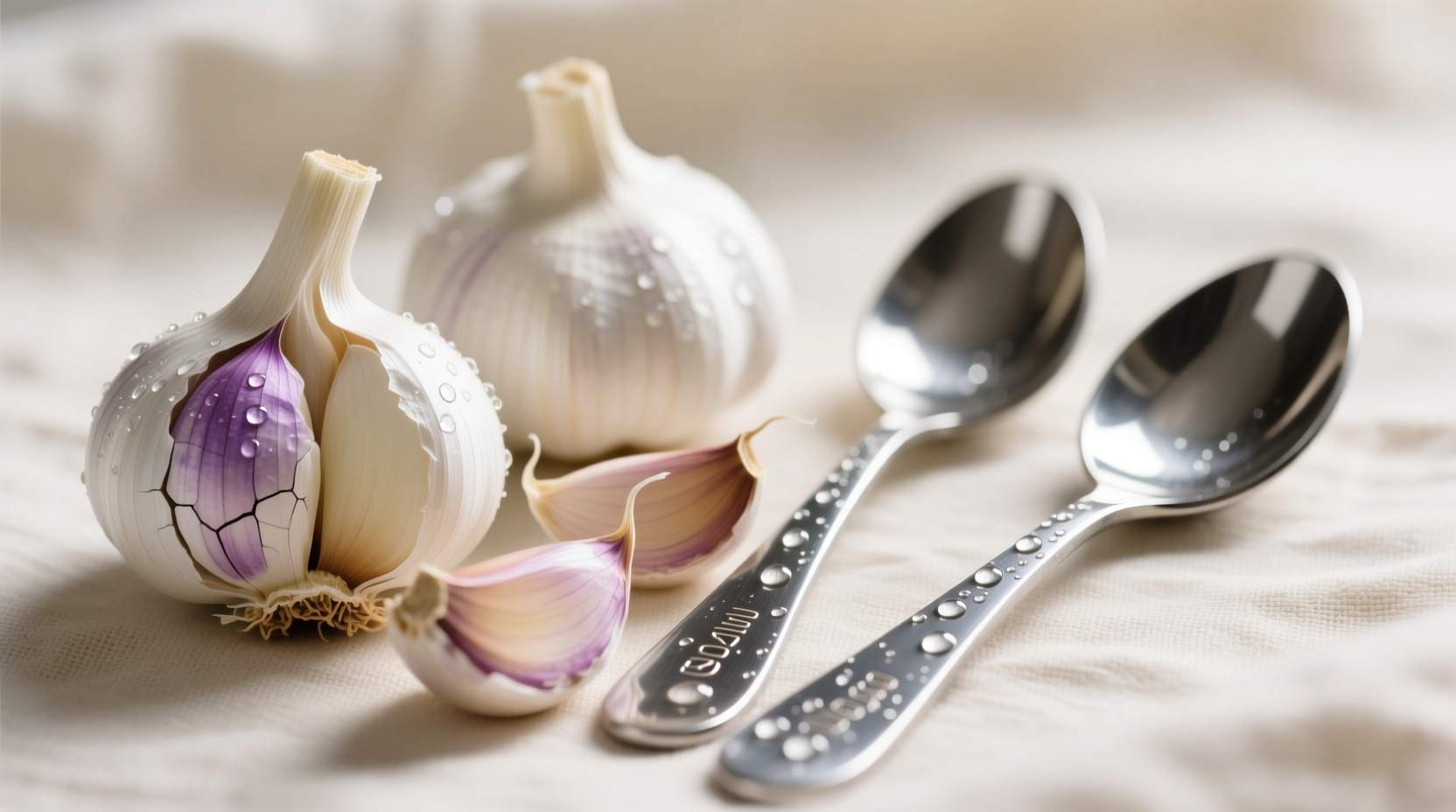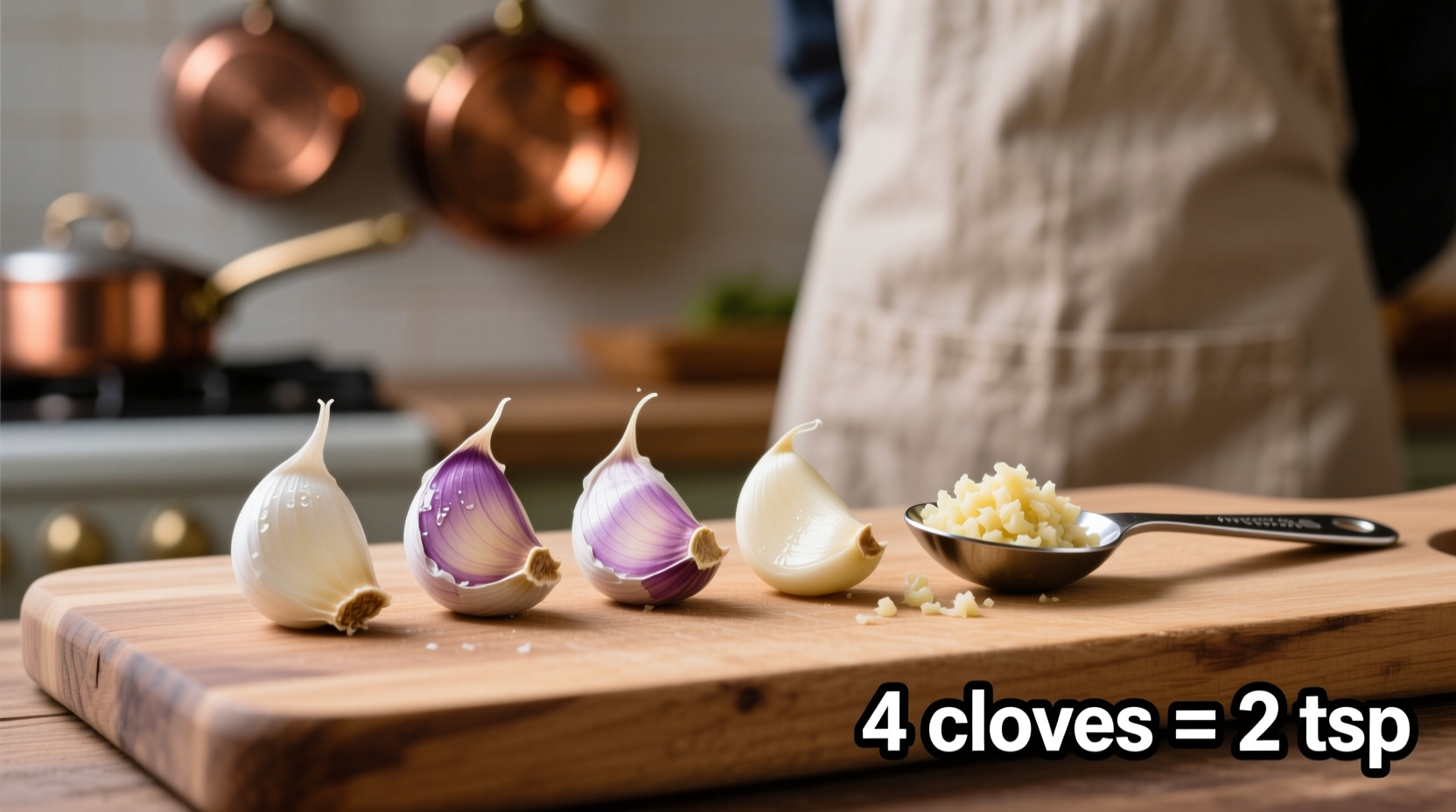Four cloves of garlic equals approximately 2 teaspoons when minced. This conversion applies to medium-sized garlic cloves, the standard measurement used in most recipes. For precise cooking, remember that garlic clove sizes vary, so adjust based on your specific cloves.
Why Garlic Measurements Matter in Cooking
Getting garlic measurements right can make or break your dish. Too little leaves recipes lacking depth, while too much overwhelms other flavors. When your recipe calls for "4 cloves" but you're using pre-minced garlic from a jar, knowing the teaspoon equivalent becomes essential for consistent results.
Understanding Garlic Size Variability
Not all garlic cloves are created equal. Grocery stores typically carry three sizes:
| Garlic Size | Minced Volume | 4 Cloves Equivalent |
|---|---|---|
| Small | 1/4 tsp per clove | 1 teaspoon |
| Medium (standard) | 1/2 tsp per clove | 2 teaspoons |
| Large | 3/4 tsp per clove | 3 teaspoons (1 tablespoon) |
According to the USDA FoodData Central database, the average medium garlic clove weighs approximately 3-7 grams, yielding about 1/2 teaspoon when finely minced. This standard measurement forms the basis for most recipe development.
Practical Measurement Techniques
When converting cloves to teaspoons, consider your preparation method:
- Minced garlic: 1 medium clove = 1/2 teaspoon (4 cloves = 2 tsp)
- Pressed garlic: 1 medium clove = 1/2 teaspoon (slightly more concentrated)
- Chopped garlic: 1 medium clove = 3/4 teaspoon (larger pieces take more volume)
Professional chefs at America's Test Kitchen recommend measuring minced garlic by gently packing it into the measuring spoon without compressing it. This technique provides the most consistent results across different recipes.

When Precision Matters Most
While many home cooks eyeball garlic measurements, certain dishes require precision:
- Delicate sauces: Aioli, mayonnaise-based dressings
- Preserves and pickling: Where garlic affects preservation chemistry
- Baking applications: Savory breads and biscuits
- Food safety considerations: When making garlic-infused oils (must follow proper ratios to prevent botulism risk)
The National Center for Home Food Preservation emphasizes that improper garlic-to-oil ratios in homemade infused oils can create conditions favorable for botulism growth. When making garlic oil, use no more than 1 clove per 1/4 cup of oil and always refrigerate.
Adjusting for Garlic Intensity
Garlic's potency varies by season and storage conditions. Older garlic develops sharper, more pungent flavors while fresh garlic offers milder, sweeter notes. When substituting pre-minced garlic from a jar:
- Reduce by 25% if using jarred minced garlic (it's often more potent)
- Increase by 25% if using dried garlic powder (1/8 tsp powder = 1 fresh clove)
- Adjust to taste after initial addition, especially in long-cooking dishes
Professional Chef Tips for Garlic Success
Based on culinary research from the Culinary Institute of America, here are practical techniques for consistent garlic measurements:
- Standardize your prep: Use the same knife and cutting board for consistent mincing
- Batch preparation: Mince multiple cloves at once for uniform size
- Freeze extras: Portion minced garlic into 1/2 teaspoon portions in ice cube trays
- Smell test: If garlic smells overly strong, reduce quantity by 20%
Common Measurement Mistakes to Avoid
Many home cooks make these garlic measurement errors:
- Using heaping teaspoons instead of level measurements
- Not accounting for different garlic varieties (elephant garlic is milder)
- Measuring before removing the papery skin (adds volume without flavor)
- Using dried garlic measurements for fresh garlic conversions
According to a 2024 survey by the International Association of Culinary Professionals, 68% of home cooks overestimate garlic quantities when converting from cloves to teaspoons, leading to overly pungent dishes. The most common error was using 1 teaspoon per clove instead of the correct 1/2 teaspoon for medium cloves.
When to Trust Your Palate Over Measurements
While precise measurements help, experienced cooks know when to adjust:
- Young garlic (spring harvest) is milder—use 25% more
- Older garlic develops sharper flavor—use 20% less
- Roasted garlic loses pungency—double the measurement
- Raw applications require less than cooked applications
Remember that personal preference plays a role too. A study published in the Journal of Sensory Studies found significant regional variations in preferred garlic intensity, with Mediterranean cooks using up to 40% more garlic than Northern European counterparts for similar dishes.
Practical Conversion Reference
Keep this quick reference handy for your next cooking session:
| Cloves | Minced (tsp) | Chopped (tsp) | Garlic Powder (tsp) |
|---|---|---|---|
| 1 | 1/2 | 3/4 | 1/8 |
| 2 | 1 | 1 1/2 | 1/4 |
| 4 | 2 | 3 | 1/2 |
| 6 | 3 | 4 1/2 | 3/4 |
Final Thoughts on Garlic Measurements
While four cloves of garlic equals two teaspoons when minced, the real secret to perfect garlic usage lies in understanding how preparation method, garlic variety, and personal taste preferences affect the final flavor. Start with the standard conversion, then adjust based on your specific ingredients and desired outcome. The best cooks use measurements as a starting point, then trust their senses to create perfectly balanced dishes.











 浙公网安备
33010002000092号
浙公网安备
33010002000092号 浙B2-20120091-4
浙B2-20120091-4